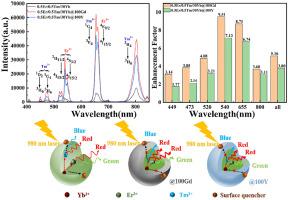Achieving up-conversion enhancement of NaGdF4:Er/Tm/Yb@NaLnF4 (Ln=Gd,Y) core-shell structured phosphors for ratiometric temperature sensing
IF 3.6
3区 物理与天体物理
Q2 OPTICS
引用次数: 0
Abstract
In this study, the temperature dependent up-conversion luminescence properties of the core-shell structured NaGdF4: Er/Tm/Yb@NaLnF4 (Ln = Gd, Y) phosphors are studied. After coating with the inert shell, the emission intensity from the phosphors is enhanced, with the maximum luminescence enhancement of 5.16 for the NaGdF4 shell and 3.80 for the NaYF4 shell. The reason for the enhancement is that the shell layers of the core-shell structured phosphors can prevent the energy transfer from the florescent center to surface defect and then improve the emission intensity from the Er3+ and Tm3+ ion. The temperature sensing properties of the 0.5Er/0.5Tm/30 Yb@100Gd and 0.5Er/0.5Tm/30 Yb@100Y phosphors are studied, with a maximum thermally coupled sensitivity (Sᵣ) of 1.1 % K−1 at 303 K and a non-thermally coupled sensitivity of 3 % K−1 at 423 K, making them suitable for temperature sensing at room and high temperature ranges.

实现NaGdF4:Er/Tm/Yb@NaLnF4 (Ln=Gd,Y)核壳结构荧光粉的上转换增强
本研究研究了核壳结构的NaGdF4: Er/Tm/Yb@NaLnF4 (Ln = Gd, Y)荧光粉的温度依赖性上转换发光特性。经惰性壳层涂层后,荧光粉的发光强度增强,其中NaGdF4壳层的发光强度增强最大,为5.16,NaYF4壳层的发光强度增强最大,为3.80。增强的原因是核壳结构荧光粉的壳层可以阻止能量从荧光中心向表面缺陷转移,从而提高Er3+和Tm3+离子的发射强度。研究了0.5Er/0.5Tm/30 Yb@100Gd和0.5Er/0.5Tm/30 Yb@100Y荧光粉的感温性能,在303 K时最大热耦合灵敏度(Sᵣ)为1.1% K−1,在423 K时最大非热耦合灵敏度为3% K−1,适用于室温和高温范围内的温度传感。
本文章由计算机程序翻译,如有差异,请以英文原文为准。
求助全文
约1分钟内获得全文
求助全文
来源期刊

Journal of Luminescence
物理-光学
CiteScore
6.70
自引率
13.90%
发文量
850
审稿时长
3.8 months
期刊介绍:
The purpose of the Journal of Luminescence is to provide a means of communication between scientists in different disciplines who share a common interest in the electronic excited states of molecular, ionic and covalent systems, whether crystalline, amorphous, or liquid.
We invite original papers and reviews on such subjects as: exciton and polariton dynamics, dynamics of localized excited states, energy and charge transport in ordered and disordered systems, radiative and non-radiative recombination, relaxation processes, vibronic interactions in electronic excited states, photochemistry in condensed systems, excited state resonance, double resonance, spin dynamics, selective excitation spectroscopy, hole burning, coherent processes in excited states, (e.g. coherent optical transients, photon echoes, transient gratings), multiphoton processes, optical bistability, photochromism, and new techniques for the study of excited states. This list is not intended to be exhaustive. Papers in the traditional areas of optical spectroscopy (absorption, MCD, luminescence, Raman scattering) are welcome. Papers on applications (phosphors, scintillators, electro- and cathodo-luminescence, radiography, bioimaging, solar energy, energy conversion, etc.) are also welcome if they present results of scientific, rather than only technological interest. However, papers containing purely theoretical results, not related to phenomena in the excited states, as well as papers using luminescence spectroscopy to perform routine analytical chemistry or biochemistry procedures, are outside the scope of the journal. Some exceptions will be possible at the discretion of the editors.
 求助内容:
求助内容: 应助结果提醒方式:
应助结果提醒方式:


